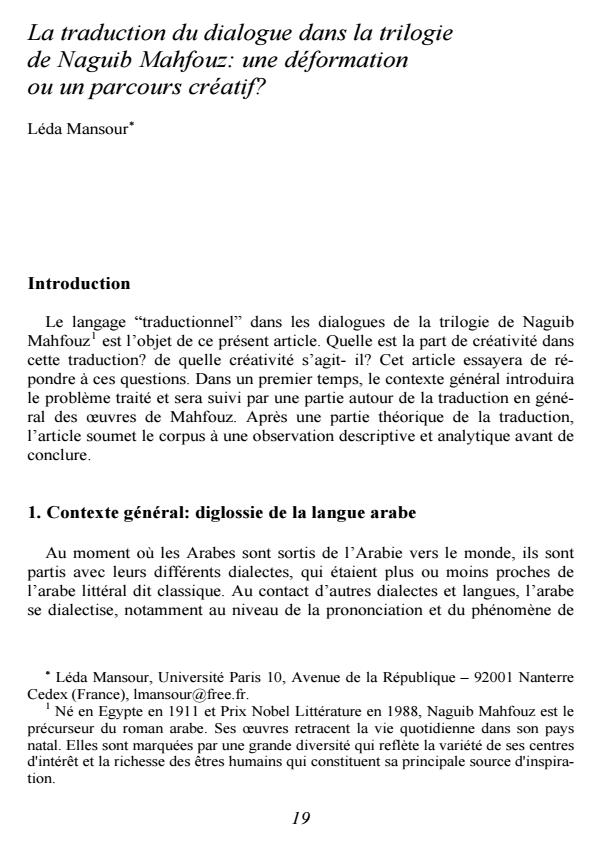La traduction du dialogue dans la trilogie de Naguib Mahfouz: une déformation ou un parcours créatif?
Titolo Rivista CADMO
Autori/Curatori Léda Mansour
Anno di pubblicazione 2008 Fascicolo 2008/1
Lingua Italiano Numero pagine 18 P. 19-36 Dimensione file 234 KB
DOI
Il DOI è il codice a barre della proprietà intellettuale: per saperne di più
clicca qui
Qui sotto puoi vedere in anteprima la prima pagina di questo articolo.
Se questo articolo ti interessa, lo puoi acquistare (e scaricare in formato pdf) seguendo le facili indicazioni per acquistare il download credit. Acquista Download Credits per scaricare questo Articolo in formato PDF

FrancoAngeli è membro della Publishers International Linking Association, Inc (PILA)associazione indipendente e non profit per facilitare (attraverso i servizi tecnologici implementati da CrossRef.org) l’accesso degli studiosi ai contenuti digitali nelle pubblicazioni professionali e scientifiche
Translation of dialogues in the Naguib Mahfouz’s Trilogy: deformation or creative path? ABSTRACT: One of the crucial problems which confronts an Arabic writer is the writing of a dialogue. The origin of this difficulty lies in the linguistic ambivalence between written classic language and dialectal vernacular language. How should a character in a novel which is written in classic language speak? What variety of language would it be? Naguib Mahfouz opts for the writing in classic Arabic where everybody speaks the same language (tongue). And what if we translate these dialogues into French? According to Salama-Carr, the translations of the dialogues of Mahfouz into French make a sort of exotication-explanation, thus, a relief of oral appears by playing on the registers of language (tongue) where from warping tendencies owed aside cumulative. The examination of the translation of the dialogues in the trilogy imposes the question of creativity: is it a question of a deformation, a transformation (conversion) or a simple imitation? In the area of creativity which translation can reveal, there would be more an idea of a creation of another dialogue in the sense that a new reading with a world of departure more or less recreated by the recipients’ vision is offered to the French-speaking reader. The translation operation thus engenders a creative movement in several senses. Keywords Dialogue, diglossia, translation, oralisation, orientalism.;
Léda Mansour, La traduction du dialogue dans la trilogie de Naguib Mahfouz: une déformation ou un parcours créatif? in "CADMO" 1/2008, pp 19-36, DOI: